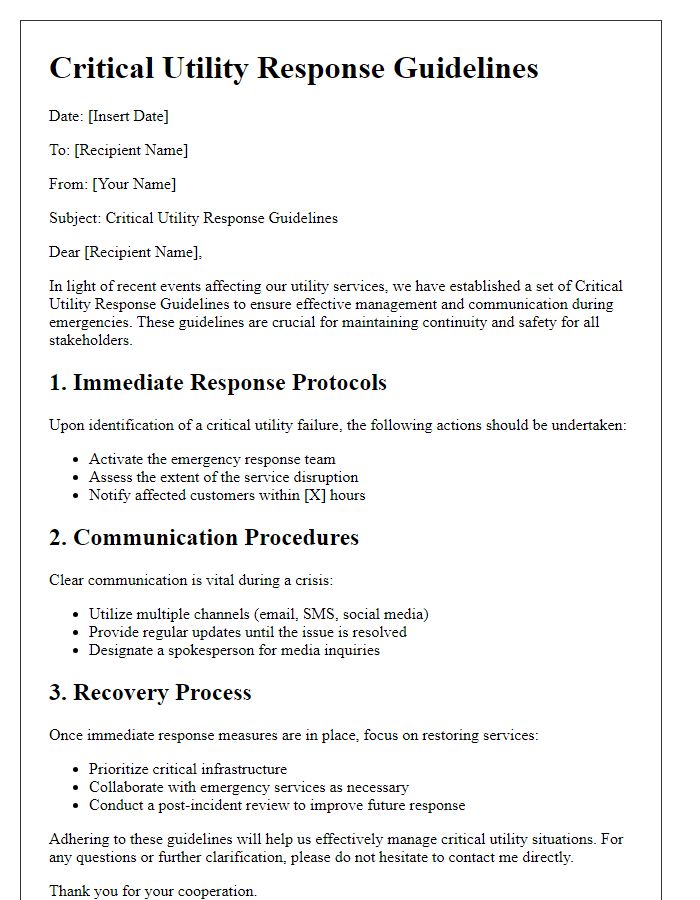In any situation involving utility emergencies, having a clear understanding of what to do can make all the difference. When you encounter issues like gas leaks, power outages, or water main breaks, it's crucial to stay calm and follow proper procedures to ensure your safety and that of others around you. This guide provides step-by-step instructions on how to respond effectively in these scenarios and whom to contact for immediate assistance. Are you ready to equip yourself with essential emergency response knowledge? Let's dive into the details!

Contact Information
In a utility emergency, swift communication is essential for safety and assistance. Local utility companies, such as Pacific Gas and Electric (PG&E) or Con Edison, provide dedicated emergency hotlines. These hotlines typically operate 24/7, allowing immediate reporting of downed power lines, gas leaks, or water main breaks. For instance, PG&E can be reached at 1-800-743-5000, while Con Edison's contact number is 1-800-752-6633. Furthermore, having text message alerts enabled can provide real-time updates about service disruptions or repair statuses. Keeping emergency contact information visible, such as on a refrigerator or bulletin board, can facilitate faster responses during critical situations.
Emergency Procedures
Utility emergency response instructions outline critical steps for addressing incidents involving power outages, gas leaks, or water main breaks. During a power outage, immediately contact your local utility company at their emergency hotline (often a dedicated number like 1-800-555-0199) to report the issue and receive updates. For gas leaks, evacuate the area and avoid using electrical devices, then notify the utility provider and local authorities. In the case of a water main break, turn off the main water supply and contact both the municipal water authority and a licensed plumber to address the situation. Always have emergency contact numbers readily available, and ensure to stay informed through local news channels or utility company alerts.
Safety Precautions
Utility emergencies, such as gas leaks (potentially explosive events) or electrical outages (causing loss of essential services), require immediate attention and adherence to established safety protocols. In the event of a gas leak, evacuate the area immediately (a safe distance of at least 100 feet from the source), avoiding sparks or open flames. Contact emergency services (911 in the United States) and alert your utility provider, such as the local gas company (e.g. PG&E in California). For electrical emergencies, do not attempt to handle downed power lines (often carrying high voltages, posing electrocution risks). Instead, maintain a safe distance and report the situation to the utility company (e.g. Con Edison in New York). Always keep an emergency kit handy, including bottled water, a flashlight, and non-perishable food items. During severe weather events like hurricanes (which can cause wide-scale disruptions), monitor official announcements for updates and follow local evacuation orders if issued.
Equipment and Tools
Utility emergency response requires essential equipment and tools to effectively manage crisis situations. Essential items include portable generators, specifically those rated at 5,000 watts or higher, to provide immediate power restoration during outages. Safety gear, such as hard hats (typically OSHA-approved), gloves, and goggles, ensures personnel protection from hazards. Communication devices, including two-way radios with a minimum range of 5 miles, facilitate coordination among emergency responders. Additionally, hydraulic rescue tools, including cutters and spreaders, enable quick access to affected areas. First aid supplies must be stocked, including bandages and tourniquets, to address injuries on-site. Trucks equipped with winches rated for at least 8,000 pounds are crucial for debris removal and clearing pathways. Regular inspections and maintenance of all tools ensure optimal functionality during emergencies.
Communication Protocols
In emergency response situations, established communication protocols are crucial for ensuring efficient coordination among utility companies, first responders, and affected communities. For example, during the aftermath of a hurricane (Category 3 or higher), utility companies must implement real-time communication strategies to disseminate information about power outages, estimated restoration times, and safety precautions. Designated emergency operation centers (EOCs) should be activated to facilitate communication between various agencies, including local government, emergency management, and public safety organizations. Utilizing multiple platforms such as social media, texts alerts, and local radio broadcasts strengthens outreach efforts and keeps the public informed. A standardized reporting system, potentially involving the Incident Command System (ICS), ensures seamless information sharing, allowing responders to prioritize areas most in need of assistance.













Comments